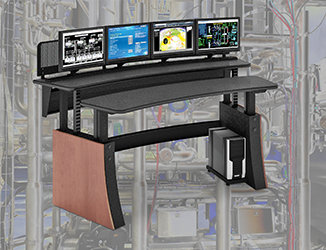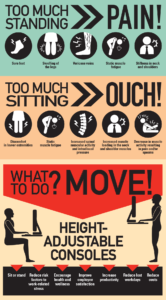
Sit/stand consoles provide relief for operators around individual work areas
Mike Edwards
Features video
Studies show that alternating between sitting and standing every hour will help reduce fatigue and may increase productivity. In demanding control room environments such as security, process control, power and military, employees are often required to sit tethered to their consoles and workstations for extended periods of time.
Additional challenges include the sharing of workstations and job responsibilities during these types of 24/7 work lives. With all of these demanding functions, tasks and work schedules, control room operators will often go without proper breaks when closely watching monitors, important pressure gauges, security movement and live action. Studies show sedentary lifestyles – whether at work or at home – can cause fatigue, pain, stress and other detrimental conditions.
The human body is meant to move. The advances in technology that have made life and businesses more efficient have also contributed to reduced physical movement in the workplace. Working at a monitor, sending internal emails, instant messaging, texting or just picking up the phone, as opposed to walking down the hall for a conversation with a colleague, have employees remaining at their workstation now more than ever.
 Studies show that sitting for extended periods of time can decrease blood flow and cause muscle fatigue, leaving employees feeling antsy and fidgety throughout the day. Movement throughout the day is very important as it helps keep the spine, circulation and muscles healthy when compared to prolonged inactivity, which can have adverse affects.
Studies show that sitting for extended periods of time can decrease blood flow and cause muscle fatigue, leaving employees feeling antsy and fidgety throughout the day. Movement throughout the day is very important as it helps keep the spine, circulation and muscles healthy when compared to prolonged inactivity, which can have adverse affects.
Studies also report that standing for extended periods of time can be just as detrimental to employee health as prolonged sitting. Extended standing without the relief of sitting or movement, such as walking, uses more of the body’s energy and can leave workers feeling fatigued.
According to research, physical movement such as alternating between sitting and standing can make a significant difference in physical health and well-being in the workplace. Interspersing sitting with standing while tethered to a desk, holding stand-up meetings and utilizing innovative ergonomic workplace products to increase physical mobility as much as possible during all work shifts are great options to help increase employee health, wellness and productivity.
Innovative technical furniture to help employees and employers achieve healthier movement in today’s workplace was the intent of height-adjustable consoles, workstations and desks that allow everyone to alternate between sitting and standing. Studies show that alternating between sitting and standing every hour will help reduce fatigue and may increase productivity.
As well as increased productivity, healthier employees have fewer lost workdays due to illness, which can relate to reduced operating costs and increased profitability. For employers, increasing productivity, employee health and wellness, and reducing costs are all benefits that can be achieved, and one strategy is implementing height-adjustable consoles, workstations and desks.
 While all work environments can differ greatly, the human body was meant to move. Studies researching the effects of prolonged sitting have shown short- and long-term physical ailments ranging from slight discomfort and fatigue to more serious conditions.
While all work environments can differ greatly, the human body was meant to move. Studies researching the effects of prolonged sitting have shown short- and long-term physical ailments ranging from slight discomfort and fatigue to more serious conditions.
Researchers suggest that by reducing sitting time in half, American’s could increase their life expectancy. According to the National Health and Nutrition Examination Surveys, by cutting sitting by three hours each day, life expectancy could increase by approximately two years. By allowing less than two hours of TV time each day can add approximately 1.4 years to one’s life expectancy.
Interestingly enough, while all of this sitting is deemed unhealthy, most people who have sedentary lifestyles also don’t enjoy sitting so much of the time. Studies show that 86 percent of people have sedentary jobs and that 67 percent of those workers do not like sitting all day long. Because of many work environments, sitting all day is simply the way workers perform their jobs. Many people would prefer to move around in the workplace much more frequently.
During a 2013 TED Talk (video below), Nilofer Merchant, a business consultant, discussed the value of physical movement and how that positively affects brain activity.
The modern work environment is set up for constant sitting and health professionals are now beginning to determine and become aware of how sedentary lifestyles can negatively impact our health in the long term.
Studies and brain scans have shown the differences in brain activity that result after a 20-minute walk and mental activity that occurs after restful sitting. The results are often shocking. The connections between physical activity and brain activity are becoming more apparent as connected functions. Often many people experience better thinking and come up with better ideas while performing some level of physical activity.
Cutting sitting by three hours each day, life expectancy could increase by approximately two years.
Fortunately, new technical furniture advancements, such as height-adjustable consoles, workstations and desks are just one of the many tools designed to keep up with changing practices in control room environments while encouraging employees to keep moving throughout the day.
This article was excerpted from the white paper, Sit/Stand Consoles, from Winsted.
Print this page